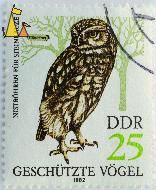Many farmland bird species have declined markedly in Europe in recent decades because of changes in agricultural practice. The specific causes vary and are poorly known for many species. The Little Owl, which feeds extensively on large invertebrates and is strongly associated with the agricultural landscape, has declined over most of northwestern Europe, including Denmark. We investigated the likely reasons for the population decline in Denmark by identifying patterns of local extinction (scale, 5 × 5 km2) and estimating demographic parameters affecting local survival, focusing on changes over time and their relationship to habitat characteristics.
The distribution of the Little Owl in Denmark contracted considerably between 1972–74 and 1993–96. The extent of contraction varied across the country, and the only habitat correlate was that local disappearance was associated with smaller amounts of agricultural land. Analyses of ring recovery data suggested a constant annual adult survival rate of 61% from 1920 to 2002, which is similar to estimates from countries with stable populations. First-year annual survival rates were much lower than values previously reported. From the 1970s into the 21st century, the mean number of fledglings declined from around 3 to < 2 young per territory, but the decline in clutch size was considerably less. Reproductive parameters were higher closer to habitat types known to be important foraging habitats for Little Owls, and were also positively correlated with the amount of seasonally changing land cover (mostly farmland) within a 1-km radius around nests as well as temperatures before and during the breeding season. Experimental food supplementation to breeding pairs increased the proportion of eggs that resulted in fledged young from 27 to 79%, supporting the hypothesis that the main proximate reason underlying the ongoing population decline is reduced productivity induced by energetic constraints after egg-laying. Conservation efforts should target enhancement of food availability during the breeding season. Other farmland species dependent on large invertebrates are likely to share the problems that Little Owls face in modern agricultural landscapes.
Source:
KASPER THORUP, PETER SUNDE, LARS B. JACOBSEN, CARSTEN RAHBEK
Ibis, Volume 152, Issue 4, pages 803–814, October 2010
http://onlinelibrary.wiley.com/doi/10.1111/j.1474-919X.2010.01046.x/abs…

- Login om te reageren
